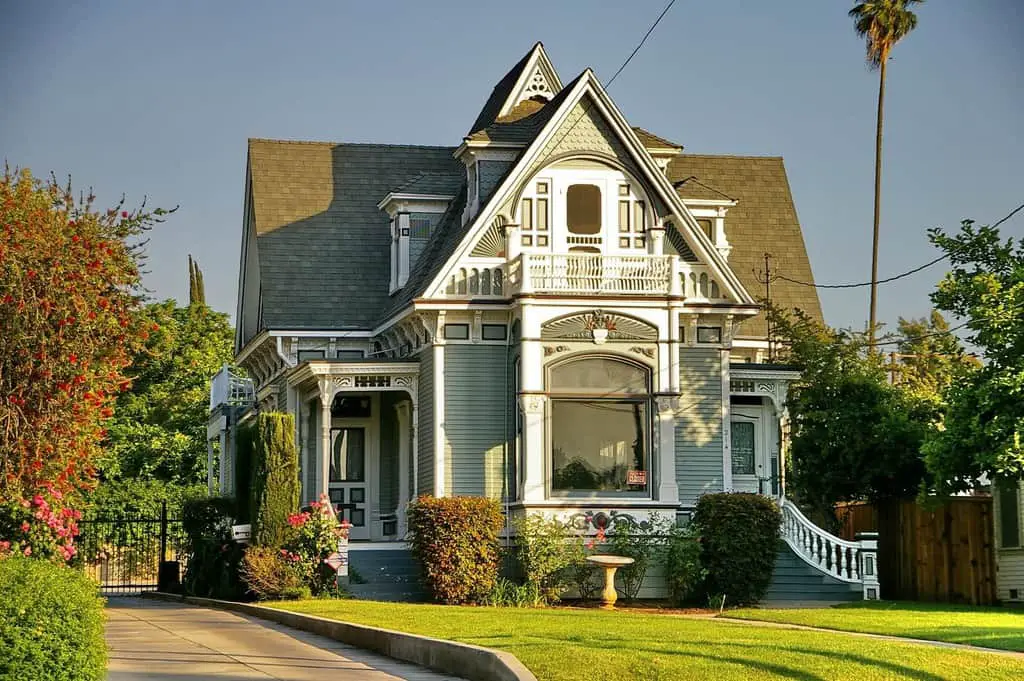People have historically used foundation plantings to conceal the foundations of older homes. Now-a-days, planting a row of bushes to mark the foundation doesn’t seem to be as popular or prominent as it once was.
However, landscaping experts say that front-yard plantings are utilized to enhance the look of a property, integrate it into its surroundings, and provide an appealing entry. Real estate professionals will tell you that curb appeal makes a huge difference when it comes time to sell your house.
Putting the right bushes in front of your house can make all the difference. It can turn your dull landscape into something more inviting!
Table of Contents
Why Should You Put Plants in Your Front Yard?
Without some lovely front yard plantings, a house doesn’t appear “complete.” It would seem like something is lacking in your front yard.
There are several apparent and practical advantages to growing foundation plants (front-of-house plants). Low-growing bushes conceal the foundations of the property, making a seamless connection from garden to home.
The correct foundation plants may make your home more beautiful and appealing, as well as improve its worth. When people see your house from the street, they’ll notice how it stands out!
Front-of-House or Foundation Plants: What to Look For
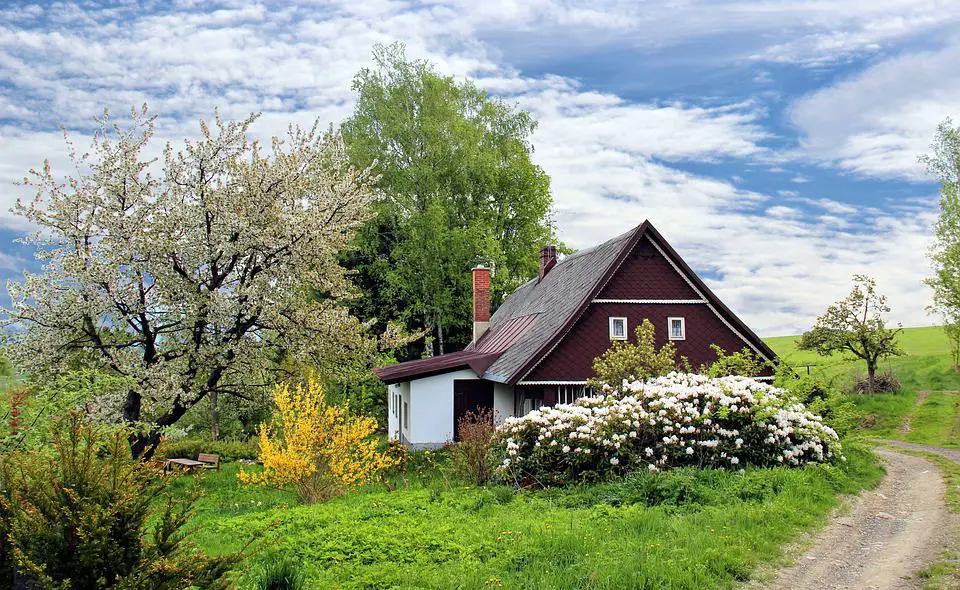
Wintercreeper (Euonymus fortunei), boxwood (Buxus spp.), holly (Ilex), and rhododendrons are all good low-maintenance bushes to use as front-of-yard plants. The foliage of these short, bushy evergreen shrubs lasts all year. Plants can be grown in full sun or moderate shade. They’re drought-resistant and don’t get too big.
Foundation plantings should include low-growing shrubs that are appealing all year. These bushes are great since they will not obstruct your view out the window. When picking plants for your front yard, keep in mind how much sun it gets—some foundation plantings require full sun, while others thrive in the shadow.
Drought-tolerant plants are also great for planting in front of the house. Allowing the soil to dry between waterings helps to keep your home area dry. That’s why planting short bushes three feet apart is a smart idea. Air movement around plants near your foundation also aids in keeping moisture from entering your home.
Try not to plant shrubs or small trees with invasive roots since they might damage your home’s foundation. Plant these bigger bushes at least five feet away from your house.
Excellent Front Yard Landscaping Plants
Here are some fantastic front yard landscaping bushes to dress up your area! You have various choices, whether you like flowers, unique growth habits, or stunning seasonal colors.
Hydrangea
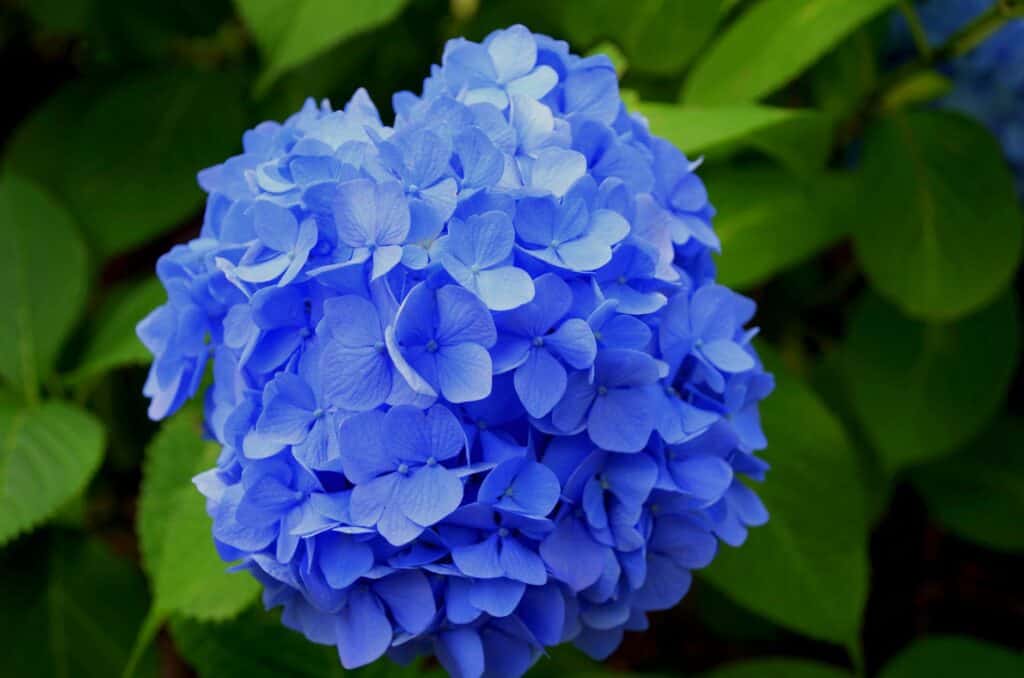
Hydrangeas are excellent front-of-house landscaping plants because of their low-maintenance demands and spectacular bloom clusters throughout the summer.
Did you know that a hydrangea bloom’s color can be changed by tweaking the soil’s pH level?
Hydrangeas are deciduous decorative foundation shrubs with enormous globular flower clusters. They are big blooming shrubs that reach 3 to 5 feet. Hydrangeas come in various sizes and have compact, short growth, making them excellent for smaller areas and the front yard.
Hydrangeas are low-maintenance landscaping bushes with moderate water requirements and no soil preferences. Although hydrangea plants need some shade and protection, certain hydrangea blossoms thrive in full sun. The only maintenance these bushes require is the removal of wasted blooms.
Hydrangea blooms flourish for several weeks in the summer and come in various colors: lavender, blue, pink, white, green, purple, and red. USDA zones 3–9 are favorable for most hydrangea varieties.
Plant a modest type of easy-to-care-for hydrangea shrub in front of the home as an accent blooming plant, or grow them in a row to make a beautiful hedge. In addition, the lovely big blossoms look beautiful in cut flower floral arrangements.
Some of the best hydrangea bushes for foundation planting in the front yard are:
- Hydrangea paniculata ‘Little Lime.’ – (also known as Panicle hydrangea) is a small dwarf shrub for the front of the home that grows no more than 5 feet tall. Summer brings lime green flowers that become pink as they develop. This plant is ideal for pots and bulk plantings. If you like beautiful cut flowers, this plant is a great choice.
- Hydrangea macrophylla ‘Nikko Blue.’ – One of the most favored mophead hydrangea bushes for foundation planting is ‘Nikko Blue.’ You will like its large blue inflorescences, massive green foliage, and the bush’s overall rounded form. Flower buds develop on the growth from the previous year. Flowers in acidic soils are blue, whereas those in alkaline soils are pink. This hydrangea shrub reaches a height and width of 4 – 6 feet (1.2 – 1.8 meters) and blooms throughout the summer. It accepts coastal conditions but is only hardy to zone 6 in the winter.
- Mountain Hydrangea (Hydrangea Serrata) – The mountain hydrangea has long been a close second to the more well-known and praised mophead hydrangea (Hydrangea macrophylla). Mountain Hydrangea is a smaller hydrangea variety with beautiful light blue or light pink blooms and rich green leaves. Ideal for use as a colorful bush border or in front of the home. It may reach a height of 2 – 4 feet (0.6 – 1.2 meters) and the same width.
- Hydrangea macrophylla ‘Endless Summer Bloomstruck.’ – A tough mophead hydrangea with rounded growth characteristics and two-toned pink or lilac blooms. It may reach a height of 3–4 feet (1–1.2 meters) and a width of up to 5 feet (1.5 meters). Hydrangeas of the Endless Summer series are a selection of bigleaf Hydrangeas. Bigleaf Hydrangeas bloom predominantly on last year’s growth, often known as “old wood.” You should never trim Bigleaf Hydrangeas in the late summer or fall because of this. Removing last year’s growth essentially eliminates the bloom buds for the following season. It’s best to wait until middle to late spring to prune so you can easily spot the winter-damaged canes.
- Hydrangea arborescens ‘Annabelle’ – This straight species is endemic to the eastern United States, specifically in Anna, Illinois. The plant’s name ‘Annabelle’ comes from the area’s women or ‘belles.’ This front-of-house bush produces big (8-12 inches) brilliant white blooms—stunning and long-lasting. The tight, rounded growth habit of ‘Annabelle’ hydrangea renders it excellent for foundation planting. This low-maintenance landscape shrub grows 3–5 feet (1–1.5 meters) high and 4–6 feet (1.2–1.8 meters) broad.
Rose of Sharon (Hibiscus syriacus)
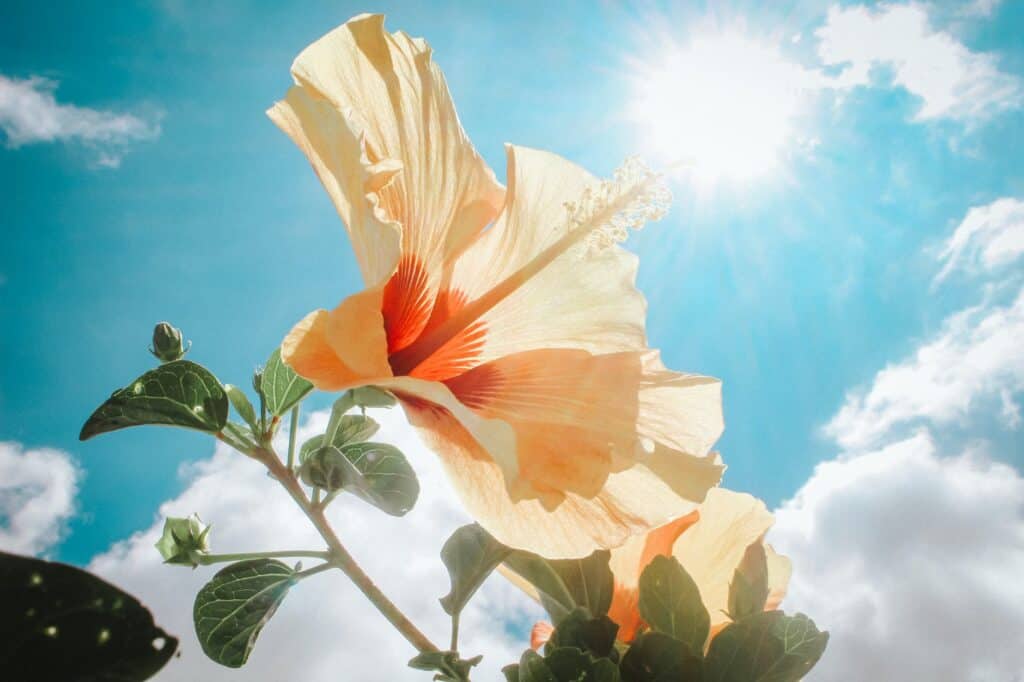
Hibiscus syriacus is a member of the Malvaceae family of plants. This flowering plant is originally from south-central and southeast China, although it has spread far over Asia.
The Rose of Sharon (Korean: mugunghwa) is the national flower of South Korea!
You should try the Rose of Sharon shrubs, specifically the Satin and Chiffon series, if you want a hardy, deciduous shrub that flowers for months yet is easy to maintain. Both kinds grow rapidly, don’t need to be pruned, and generate almost no seeds so that they won’t multiply all over the garden.
Anemone-shaped flowers in purple, pink, white, or blue adorn the Chiffon variants. Meanwhile, Satin variants have solitary pink, purple, or blue blooms with a deep red eye.
Rose of Sharon exists in a variety of sizes, most of which are pretty big. Satin and Chiffon variants reach a height of 8-12 feet and are typically taller than broad. As a result, they’re ideal for hedging, screening, or planting near a tall, bare wall where a splash of color will change everything.
Shasta Daisy (Leucanthemum x superbum)
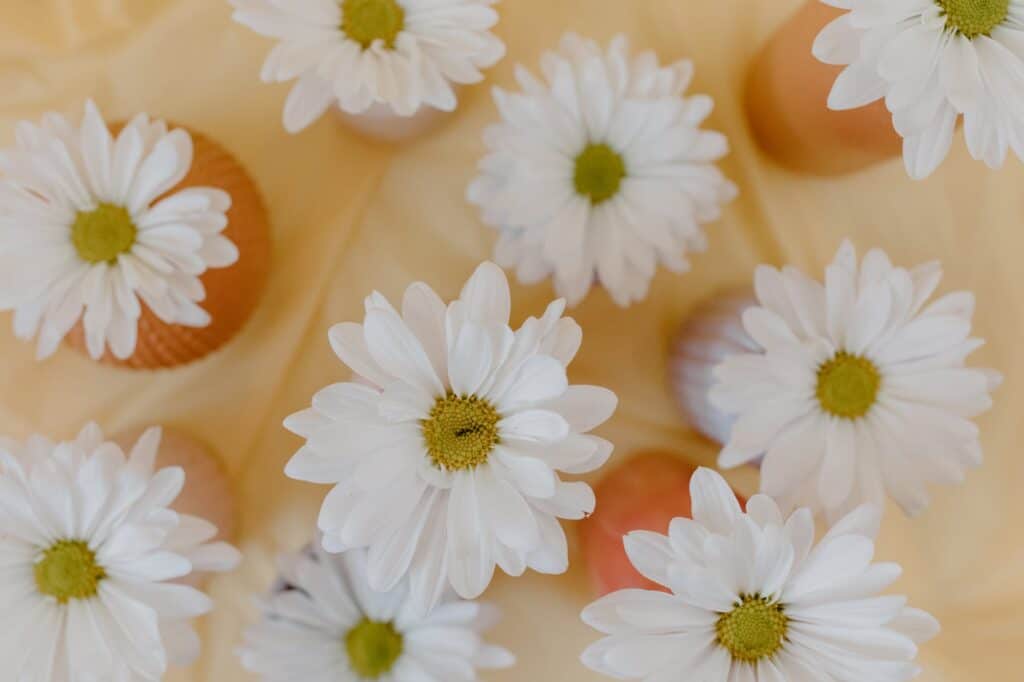
The Shasta Daisy (Leucanthemum x superbum) is a classic herbaceous perennial with a conspicuous and stunning flower show and lovely, rich dark green foliage that provides weeks of brilliance beginning in early to mid-summer.
Because of the abundance of cultivars displaying varying flower sizes and types, levels of compactness, and bloom duration, there is a Shasta Daisy for just about every garden. Shasta Daisy plants like moist, well-drained, rich soil.
- Leucanthemum × superbum ‘Becky.’ – ‘Becky’ grows taller than most other Shasta varieties, reaching 3-4′ high. An abundance of 4-inch sized flowers of white petals with yellow centers occurs from mid-summer to early fall. Another thing you’ll like about Shasta Daisy’s stiff stems is that they don’t require staking. These plants can reach a height of 4 feet and a width of 3 feet. It would look lovely planted with ‘Snow Lady,’ a shorter variety that blooms sooner, for a more extended display of color. ‘Becky’s cut flowers are of exceptional quality. This plant thrives in Hardiness Zones 4-9.
- Leucanthemum ‘Crazy Daisy’ – ‘Crazy Daisy’ will stand out in front of your house with its semi-double and double cream-white blooms with yellow centers. This bush will look particularly lovely in perennial borders and beds. Plant Crazy Daisy if you want cuts that are strong and erect and are taller than 26 inches. Crazy Daisy survives in hardiness zones 4 to 9. This bush will attract lots of butterflies, but it is resistant to deer and rabbits.
- Leucanthemum ‘Banana Cream’ – ‘Banana Cream’ produces large 4-5″ lemon yellow blooms with a creamy white center. In the summer, the bloom period is extended. This variety was a mix between ‘Broadway Lights’ and ‘Sunny Side Up.’ Banana Cream is a prolific grower with dark green, disease-resistant leaves. It looks great in containers or the garden, and it grows to approximately 18 inches. This plant is hardy in zones 5-9.
- Leucanthemum ‘Brightside’ – This plant is Becky’s seed strain. From late spring until summer, huge, pure white daisies bloom. Taller than 3 feet and hardy in zones 5-9. This bush will undoubtedly draw in all the butterflies! It can use some shade, especially in hot summer regions or when planted in relatively dry soils. To encourage more bloom, remove dead flower heads. To promote vitality, separate clumps as needed (every couple of years).
- Leucanthemum ‘GoldFinch’ – If you like yellow, you’ll like this flowering bush! ‘GoldFinch’ is as yellow as a Shasta Daisy can get. It’s a darker yellow than ‘Banana Cream,’ plus its flowers will last longer. This front yard bush is a true treasure. With a lengthy flowering time, compact form, with beautiful semi-double blooms that fade from brilliant lemon yellow to ivory white over time. Its height can get up to 2 ft (90 cm). It is hardy in zones 5-8.
- Leucanthemum ‘Victorian Secret’ – Even under high heat, this neat, compact cultivar has gently ruffled long-lasting blooms without the smell! Taller than 14 in (35 cm). Hardiness zones 5 to 9 are suited for this plant, blooming in June, July, and August.
Cavatine Dwarf Japanese Pieris (Pieris japonica ‘Cavatine’)

Pieris japonica ‘Cavatine’ is a tiny, flowering shrub with evergreen leaves. The ‘Cavatine’ plant is an excellent front yard plant that may reach a height of 2 feet (0.6 m). The cream-white blooms provide a splash of color to the dark green background. This low informal hedge plant is also known as the lily-of-the-valley shrub.
In your front yard, dwarf ‘Cavatine’ bushes thrive in direct sunlight or part shade. They are drought-tolerant plants. Japanese Pieris foundation plants thrive in zones 6–8.
Pieris spp., similar to rhododendrons, contain grayanotoxins I, II, and III (polyhydroxylated diterpenes). These chemicals latch to sodium channels in the heart, skeletal muscle, and nerve cells, keeping them depolarized. In cows and goats, the hazardous dosage of the green plant is 0.2-0.6 percent of the animal’s weight.
Creeping Gardenia
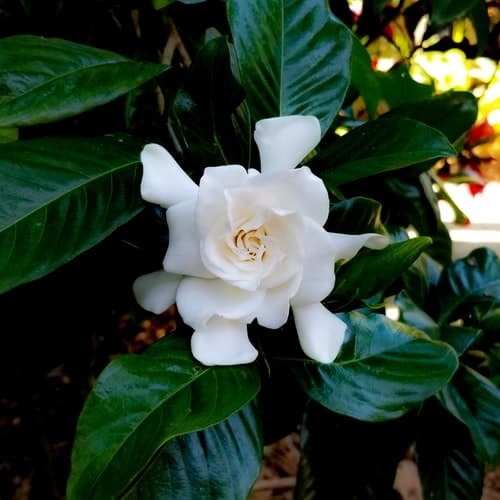
Creeping gardenia is a low-growing bush that grows 2 feet tall and 2-3 feet broad. It blooms with beautiful, scented white blossoms in July. Sun exposure ranges from moderate to full.
A study found that peat moss is the best growing medium for Creeping Gardenia.
If you want a taller shrub, Frost Proof is another wonderful Gardenia. It reaches a height of around 5 feet.
Boxwood (Buxus) Shrub – A Great Foundation Plant
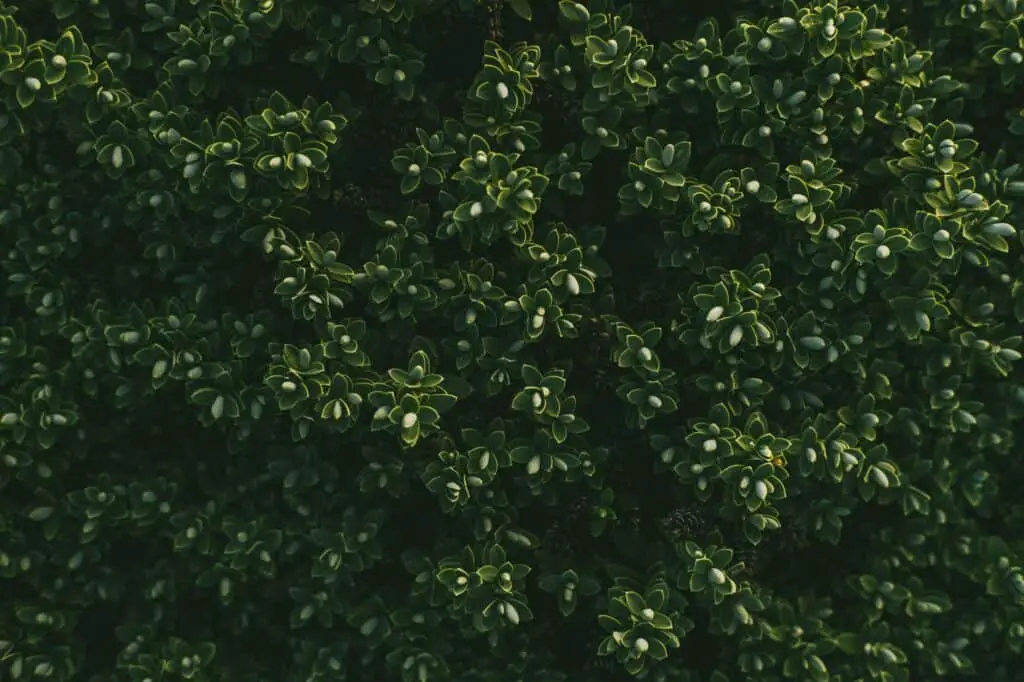
You will find Buxaceae species in the tropics, subtropics, and temperate zones all over the world.
Low-growing, dense boxwood shrubs are excellent for foundation planting for your front yard.
Boxwood shrubs naturally come from Europe and Asia. These evergreen landscaping plants have many branches and a bunch of uses, especially for the front area of your house.
Boxwood is a relatively easy-to-maintain foundation plant that offers lush, thick evergreen leaves and bushy growth. These low-maintenance shrubs are simple to shape, and most varieties don’t go much taller than 3 or 4 feet.
Numerous kinds of boxwood may be grown in full sun, moderate shade, or full shade. Zones 5–9 are ideal for the hedge plants. Boxwoods flourish on well-draining soil and are drought resistant in most cases.
Boxwood does not do well in extreme heat and cold. They are particularly vulnerable to foliar desiccation as a result of the dry winter air. A reddish-orange to brown color shift anywhere near the midrib or inner section of the leaf is a common sign of winter damage on boxwood.
Some of the nicest boxwood shrubs for planting in your front yard are as follows:
- Common Boxwood (Buxus sempervirens ‘Suffruticosa’) – The common boxwood (Buxus sempervirens ‘Suffruticosa’) is an excellent choice for foundation planting. The petite boxwood has evergreen foliage and is drought resistant, growing to a height of 2 to 3 feet (0.6 – 1 m). It thrives in bright sunlight to partial shade and uniformly moist, well-drained loamy soil. It can thrive in various soil types and even in full shade, but it will be less prolific and have fewer leaves than if planted in ideal conditions. Plant common boxwood for traditional short hedges, shade, sun ground cover, or a container doorway plant.
- Green Beauty Japanese Boxwood (Buxus microphylla var. japonica) – The glossy lanceolate leaves of the ‘Green Beauty’ boxwood have rich foliage. This trouble-free compact foundation shrub thrives in both the sun and the shade. Zones 6–9 are ideal for cultivating this plant.
- Boxwood ‘Winter Gem’ (Buxus microphylla ‘Winter Gem’) – ‘Winter Gem,’ or Japanese Boxwood, is native to China and Japan. It is a rounded foundation plant that grows up to 4 feet tall (1.2 m). The boxwood ‘Winter Gem’ has tiny glossy green leaves that stay green all year. Zones 6–8 are appropriate for this plant.
- English Boxwood ‘Dee Runk’ (Buxus sempervirens) – This is a perfect corner plant or entrance plant because it is a tall boxwood shrub. Buxus sempervirens are mainly cultivated for aesthetic purposes. The evergreen shrub has a vertical columnar growth and reaches about 7 feet (2 meters). All-year-round color for your front yard is provided by ‘Dee Runk’ boxwoods. And if you want to make a foundation planting hedge, you can easily shape this quickly growing plant. Zones 6–8 are acceptable for the English boxwood ‘Dee Runk.’
- Green Pillow Boxwood – The ‘Green Pillow’ boxwood is a relatively small broadleaf shrub that makes a good foundation plant. The thick shrub has the appearance of a pincushion pillow. This boxwood grows up to a foot tall as a foundation plant and survives in zones 5–8.
- Buxus ‘Green Gem’ – Buxus ‘Green Gem’ is a tiny landscape shrub with a circular mound of small, oval, dark green foliage. Low hedges are made possible by the compact growth habit of this bush. However, keep in mind that Buxus ‘Green Gem’ is one of the cultivars prone to boxwood blight, identifiable as black leaf spots, black stem lesions, and defoliation.
Redosier Dogwood (Cornus sericea)
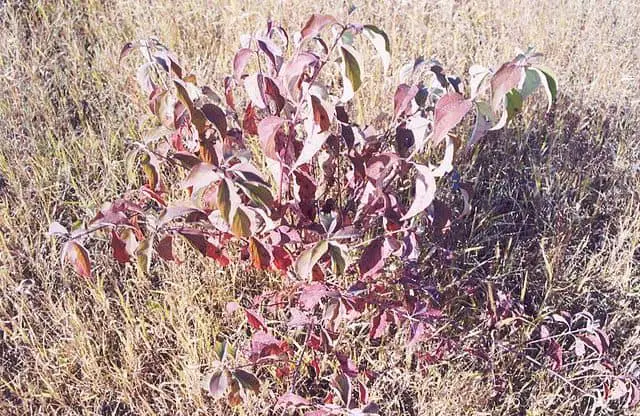
This species, often referred to as red willow, is a deciduous shrub with rich red stems that make it attractive even after losing its foliage. The Latin-specific epithet sericea (meaning: silky) accurately describes the soft texture of the plant’s foliage.
It has white blooms in late spring, which are succeeded by tiny white berries that adorn it in late summer and fall, and are consumed by no less than 18 bird species, including bobwhite quail and ruffed grouse.
Redosier dogwood grows quickly, reaching heights of seven to nine feet when fully grown. Pruning it once a year is adequate, although cutting it down to ground level helps keep the vivid red of its younger stems. Its fibrous root structure helps to prevent erosion.
Furthermore, it is resilient and beautiful even when it looks bare in the winter, and it can be propagated by cuttings, making it a low-cost option for sizeable plantings.
Wintercreeper (Euonymus fortunei) – Fantastic Foundation Plant.
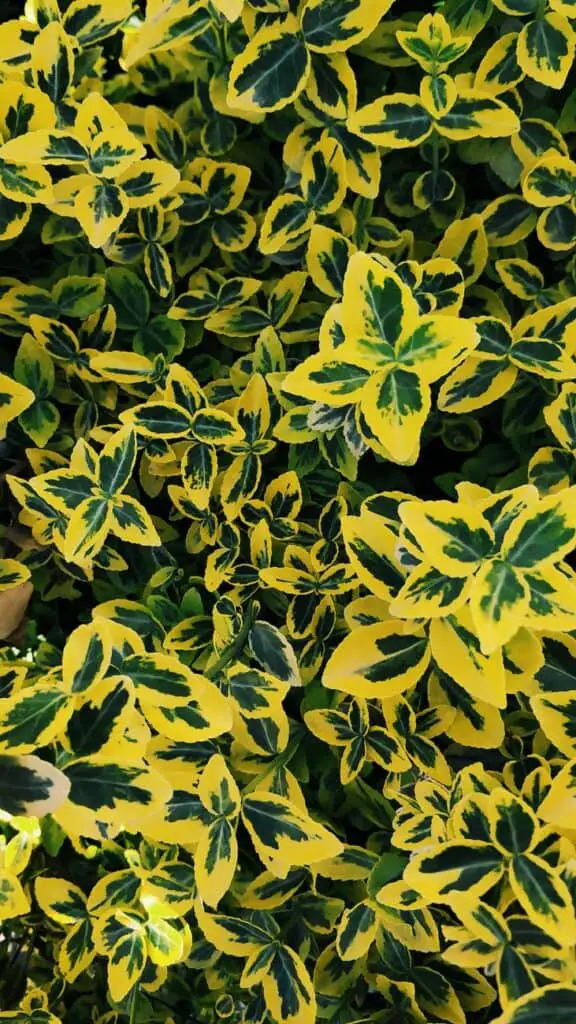
Wintercreeper bushes (also known as Climbing Euonymus, Japanese Euonymus, Spreading Euonymus, and Wintercreeper Euonymus) have golden yellow and green leaves. They are excellent plants for the front of your house. Wintercreeper cultivars reach a height of 1 to 2 feet (30 – 60 cm), making them suitable for covering foundations, edging, ground cover, and garden borders. These cold-hardy, brilliantly colored plants thrive in both the shade and the sun.
You will find wintercreeper bushes in zones 5 through 9. Consult with your state before planting them near your foundation, as they are deemed invasive in certain regions.
For foundation planting, here are several wintercreeper shrubs to consider:
- Euonymus fortunei ‘Moonshadow.’ – In bright or shady front yards, the lush yellow and green foliage offers magnificent foundation cover. The ‘Moonshadow’ wintercreeper reaches a height of 3 feet (1 meter) and a spread of 5 feet (1.5 meters).
- Euonymus fortunei ‘Emerald ‘n’ Gold.’ – With its golden and vivid green leaves, this wintercreeper will liven up your front yard. Planting around foundations in shady sections of your yard is wonderful.
- Euonymus fortunei ‘Emerald Gaiety.’ – This low-growing evergreen bush with green and white variegated leaves makes an excellent ground cover. You can use Euonymus fortunei ‘Emerald Gaiety’ as a foundation plant, low hedge, or grow along walls in brightly sunlit front yards.
‘Orange Rocket’ Barberry

Opening with vivid coral fresh growth and developing into ruby-red leaves that will keep the show running into the fall, this simple to care for ‘Orange Rocket’ Barberry will add a touch of spectacularly colored foliage to your front yard.
This deciduous shrub thrives in USDA Zones 5a to 9b and can withstand full sun to partial shade. It’s an upright bush that grows to be approximately 4-feet tall and 1.5-feet broad when fully grown.
You can certainly liven up space in front of your house with the fantastic colors of this bush! You can use it as a border, hedge, or striking accent plant.
The plant will be drought tolerant once grown and can withstand a wide range of weather conditions. The plant, like other barberries, has small thorns on it. As a result, you may utilize them as a barrier plant as well.
Kaleidoscope Abelia (Abelia x Grandiflora ‘Kaleidoscope’)

Kaleidoscope Abelia is a member of the Caprifoliaceae (honeysuckle) family. It has brightly colored, golden yellow variegated leaves and only grows 2.5 feet tall and 3.5 feet broad.
Kaleidoscope Abelia’s foliage changes as spring give way to summer: the interiors of the leaves stay green and deepen somewhat, while the borders become a golden yellow color. It’s also the time when it blooms. Throughout the plant’s surface, the slightly rosy-tinted buds develop into tubular white flowers.
It can withstand direct sunlight, and Zones 6-9 are perfect for this plant.
Plant in large groups as a front yard fixture for stunning year-round color. What’s nice about this bush is it can survive being planted in containers and spacious beds! You won’t have a problem caring for this plant as long as you keep it in moist, rich, acidic soil with good drainage.
Rhododendron – Front Yard Landscape Foundation Plant
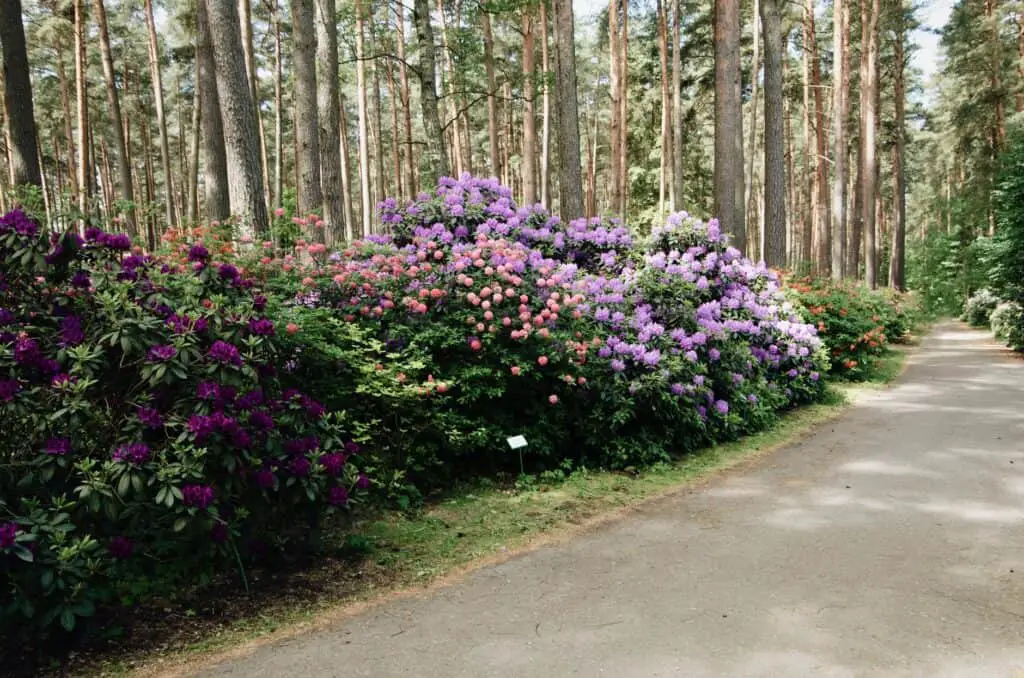
Rhododendrons are evergreen flowering bushes that look great in the front yard. Almost all rhododendron bushes are excellent foundation plants since they reach 2 to 4 feet. Rhododendrons, which are evergreen, are ideal for planting around foundations in full sun or light shade. Rhododendron bushes bloom in the spring and provide beautiful flowers.
But keep in mind that Rhododendron is toxic when ingested. Grayanotoxin, a diterpene present all over the plant (mainly leaves and pollen), causes poisoning when it comes in contact with your food. Risk factors include eating Rhododendron nectar grayanotoxins-contaminated honey and drinking Rhododendron tea.
Have a look at some of the nicest rhododendron shrubs for foundation planting in the front yard:
- Rhododendron ‘Hino Crimson – The rhododendron ‘Hino Crimson’ is a beautiful blooming plant for your house’s front area. The short bush has glossy evergreen leaves and beautiful dark pink blooms, reaching just 2 to 3 ft. tall. Plant in zones 5–9. Acidic, rich, humusy, moderately moist, well-drained soils in partial shade are ideal for growing this plant. It likes dappled sunlight or shaded open areas. It will also nicely accept morning light with midday shade.
- Rhododendron ‘April Rose’ – You will undoubtedly love Rhododendron ‘April Rose’ for its cold hardy nature and big, funnel-shaped springtime blooms, which are a little fragrant. It’s a semi-dwarf bush with lovely purplish-red flowers and broad green leaves. In the fall, the elliptical, flat, dark green leaves turn a reddish-brown color. Zones 4-8 are perfect for this front yard plant. It grows 3 to 4 feet (1–1.2 meters) tall.
- Rhododendron ‘Bow Bells’ – This tiny, broadleaf evergreen shrub is coated in beautiful clusters of fragrant pink flowers when in bloom. Throughout the winter, the glossy, dark-green foliage maintains its shade. This plant grows best in the sun to part shade.
- Dwarf Indica (Gumpo) Azalea (Rhododendron eriocarpum) – This woody, dwarf blooming shrub matures approximately 2 feet tall and is evergreen in most regions. If the soil doesn’t drain properly, full sun can burn the foliage and cause the roots to rot. With good upkeep and a healthy plant in the right area, there should be minimal issues.
- Rhododendron ‘Blue Tit’ – Blue Tit is a renowned dwarf hybrid plant with a rounded, bushy form. You will enjoy seeing its funnel-shaped, lavender-blue flowers! Expect to see these gorgeous flowers in the middle of April. This plant does well in full sun and partial shade.
- Rhododendron ‘Dora Amateis’ – Every spring, this stunning tiny shrub blooms with loads of funnel-shaped white flowers. The bushy, low-growing foundation plant thrives in both the shade and the sun. Dora Amateis is well-known for its ability to attract bees. Bees can’t resist its nectar-pollen-rich flowers. Zones 5–8 are suitable for this front yard bush.
Dwarf Yew Shrubs
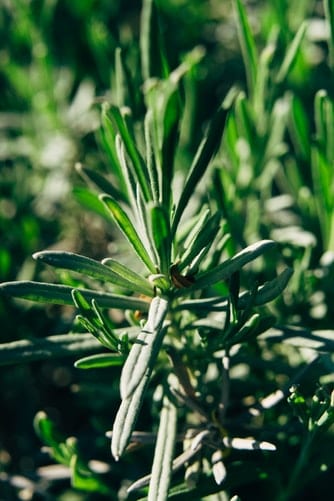
Dwarf yew shrubs are a popular choice for a front yard, evergreen landscaping bush because of their soft needles and thick growth. Many compact yews grow erect and thrive in clear daylight. Yew dwarf shrubs make beautiful foundation plants, great hedging plants, and decorative border shrubs.
They are usually not prone to insect and disease pests, plus they offer a beautiful, dark green color all year. While their leaves look so much like needles, they are essentially thin, linear-shaped, and flat with a glossy sheen to them. Yew plants seem to be either male or female, with the female producing fleshy, red berry-like seed cones called arils.
Some yews that are good for foundation planting:
- English Yew (Taxus baccata ‘Repandens’) – This is a low-lying, spreading ornamental foundation plant. English yews can reach a height of 2 to 4 feet and a width of up to 15 feet. This hardy English yew has curving branches and drooping lateral stems that spread widely. It has two levels of long, deep green, sickle-shaped needles, and berries only grow on more mature plants.
- Anglo-Japanese Yew (Taxus x media ‘Densiformis’) – The Anglo-Japanese yew is a common cross between Japanese yews (Taxus cuspidata) and English yews (Taxus baccata). They’re frequently utilized as foundation plants, specimens, grouped, or hedges when appropriately cut. Early in life, yews are very narrow, but as they grow older, they become broader. They are robust and durable, adaptable to urban areas, and one of the few evergreens that can withstand extremely shady conditions. This yew cultivar has thick foliage made up of glossy green needle-like leaves and grows close to the ground. The bushy yew reaches a height of 3 to 4 feet.
- Japanese Yew ‘Bright Gold’ (Taxus cuspidata) – This dwarf foundation bush has a spreading growth habit and reaches a height of 4 to 5 feet, although shearing and pruning can keep them at a manageable size. The cultivar’s newly growing needles are golden yellow with green stripes, with the color vibrancy peaking during the spring growth flush and lasting through the winter thanks to late-season cutting. In zones 4–7, the foundation plant thrives in full sun or moderate shade.
- ‘Densiformis’ yew – The ‘Densiformis’ yew is an excellent option for planting in shaded regions in your front yard or garden. Anglo-Japanese yew has the ideal features for a foundation plant: it’s drought-tolerant, easy to care for, and has evergreen foliage. Anglo-Japanese yews flourish in full sun, moderate shade, and full shade in zones 4–7, making them ideal for growing in front of your house.
Inkberry Foundation Plants (Ilex glabra)
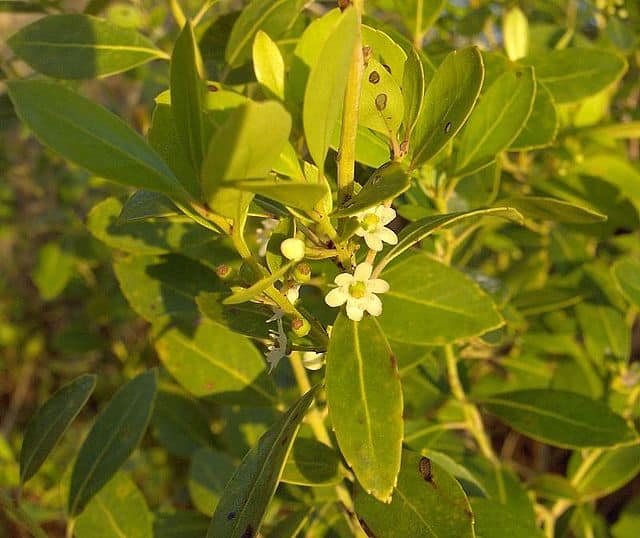
For foundation planting, we also like inkberry shrubs like the ‘Shamrock’ (Ilex glabra ‘Shamrock’). Inkberries are native evergreen bushes that produce blackberries in the fall and blooms in the summer. The dense, dark green leaves of the Inkberry ‘Shamrock’ cultivar provide year-round color in your front yard. Plants of the inkberry ‘Shamrock’ variety reach 3 to 4 feet.
Inkberry bushes thrive in both full sun and light shade. The bushy foundation plants thrive in a variety of soil conditions and tolerate damp soils. In zones 4–9, these shrubby, short, low-maintenance plants flourish.
The most significant disadvantage of inkberry holly in the landscape is its propensity for losing lower leaves and becoming exposed at the base. If you start to see your plants exhibit leafless bases, don’t be reluctant to trim them aggressively. In reality, this type is a fire-resistant plant that can withstand being fully chopped down to the ground. You should not perform such drastic pruning every year; rather, do it in late winter, if at all. Pests are rarely a significant issue.
Other inkberry foundation plants include:
- The ‘Gem Box’ inkberry – This foundation plant, which resembles boxwood, has tiny dark green leaves, compact growth, and can withstand wet soil and bright sunlight. You’ll like having this bush for its nice, neat-looking growth habit, which is a rounded shape. It looks magnificent in the landscape, rich and thick to the ground!
- Inkberry ‘Strongbox’ – Inkberry ‘Strongbox’ is a dense, low-growing shrub with tiny leaves and lush foliage that can reach a height of 3 feet (1 meter). Like ‘Gem Box,’ ‘Strongbox’ is a desirable bush in your front yard because of its compact form that would always look nice no matter what season. Except that this cultivar is slightly tougher and more disease-resistant.
Red Tip Photinia (Photinia x fraseri)
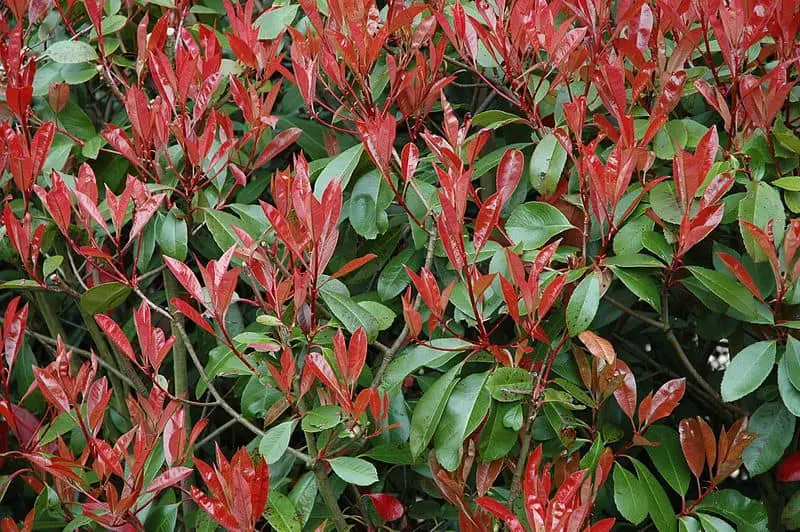
Fraser’s Photinia is a big, evergreen bush or small tree that can reach 20 feet in height. After P. serratifolia but before P. glabra, this bush blooms in the middle of spring. This plant is likewise in the middle of the two in terms of size. Many individuals find Fraser Photinia’s fetid flowers repulsive. A new leaf is a vibrant reddish-bronze hue, and you will see reddish buds throughout the year.
This plant can withstand alkalinity, as well as dryness and salt spray. It is susceptible to pests and diseases and is intolerant of damp environments.
Arborvitae Foundation Plants (Thuja)
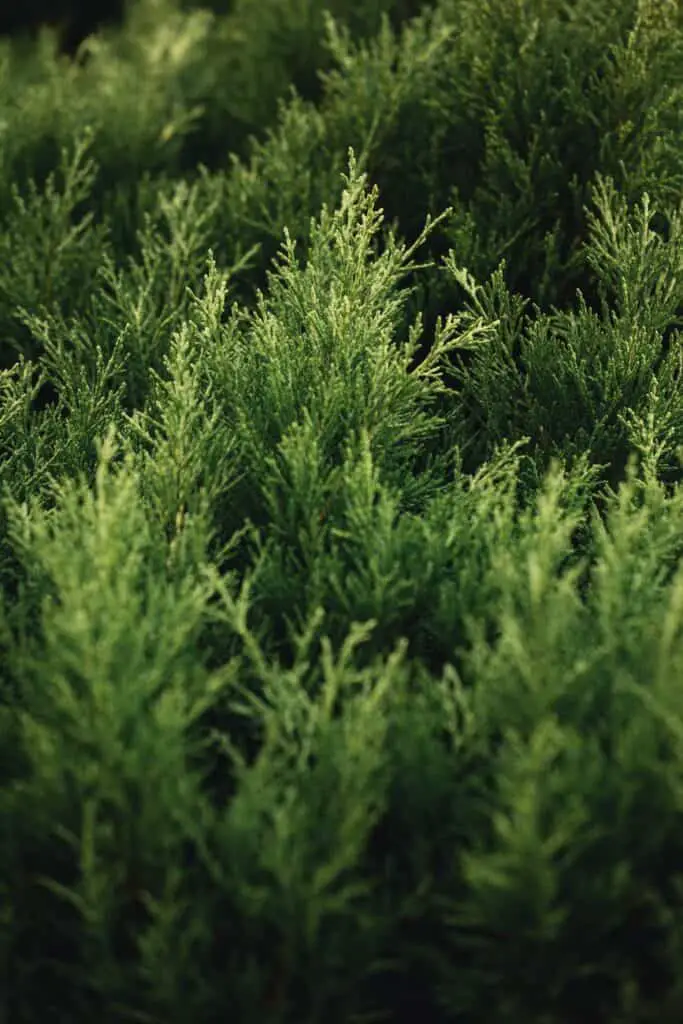
Dwarf arborvitae bushes have lush, evergreen leaves and make excellent foundation plants. The word arborvitae is Latin for “tree of life.” Increased blood pressure and a fever reduction are two effects.
Arborvitaes, especially small ones, thrive in full sun in front of your house. As corner plantings or entry plantings, you can grow larger upright, dense arborvitae trees. Zones 3–7 are suitable for arborvitae bushes.
The following are some of the best arborvitaes to plant around the foundation:
- Thuja occidentalis ‘Fire Chief’- The thick feathery leaves of this small shrub become golden yellow in the spring. In the fall, it steadily changes into green and red. This arborvitae grows slowly and is ideal for foundation plantings, short hedges, and borders. In zones 5–9, in full sun to part shade, the arborvitae ‘Fire Chief’ grows to a height of 3 to 4 feet.
- Thuja occidentalis ‘Little Giant’ – The small evergreen species, Thuja occidentalis ‘Little Giant,’ is an excellent choice for foundation plantings, as a specimen or a hedge. The arborvitae features soft green feathery leaves and a compact dome form. Little Giant needs full sunlight to live, and it has to be planted in zones 3-8. It’s a nice bush to have if you want lots of birds in front of your house.
- Thuja occidentalis ‘Hetz Midget’ – This is a needled evergreen that belongs to the family Cupressaceae. This Thuja is a lovely compact globose shrub with soft, feathery leaves and a flattened crown. If you want a great foundation plant, place this classic low-maintenance arborvitae around the front of your house. This bush will survive in full sun to part shade on typical, moderate moisture, well-drained soils. Although it tolerates a broad range of soils, it likes damp, neutral to alkaline, well-drained loamy soil. And it does not like drought. It thrives in full sun in hot summer climes, but it also loves some moderate afternoon shade.
- Dwarf Golden Oriental Thuja (Thuja orientalis ‘Aurea Nana’) – This is a miniature evergreen shrub with delicate needle leaves and golden-yellow foliage in flattened sprays. To make it conceal your house’s foundations, plant in sunny or slightly shaded front yards. Grow in full sun on rich, moderately moist, well-drained soils. In hot and dry weather, make sure to water your plants regularly. These plants open up more as they mature. In youth, the scale-like yellowish-green leaves in flat sprays become deeper green as they age. In the winter, the foliage may become a bronze color.
Catmint (Nepeta racemosa)
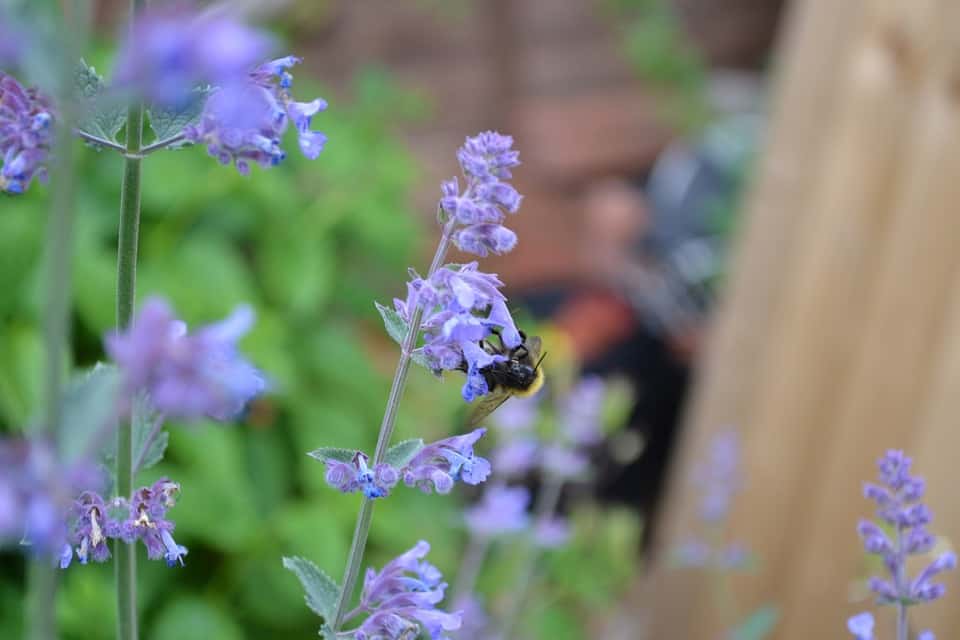
Nepeta spp. or catmint is a flowering plant belonging to the Lamiaceae (mint family). This plant is well-known for attracting cats. Want to know why? The compound nepetalactone, a vaporous iridoid that also scares away insects, is responsible for this occurrence.
Catmint bushes give you spikes of tiny blue or purple blooms that look best when clustered together. It resembles a blue-purple cloud touching the ground and is frequently cultivated in huge numbers because of its relaxed nature.
On 24-inch-tall stems that may grow to 3 feet wide, ‘Walker’s Low’ has fragrant blossoms that are a mixture of lavender, blue, and mauve. You’ll see the plant bloom in early summer, and if you deadhead the flushes, they will last until autumn.
It thrives in Hardiness Zones 4-8. The cultivar ‘Blue Wonder’ is excellent if you want small, darker blue flowers and a more compact form; this dwarf, mounding, bushy plant can live in Zones 3–8.
Dwarf Spruce
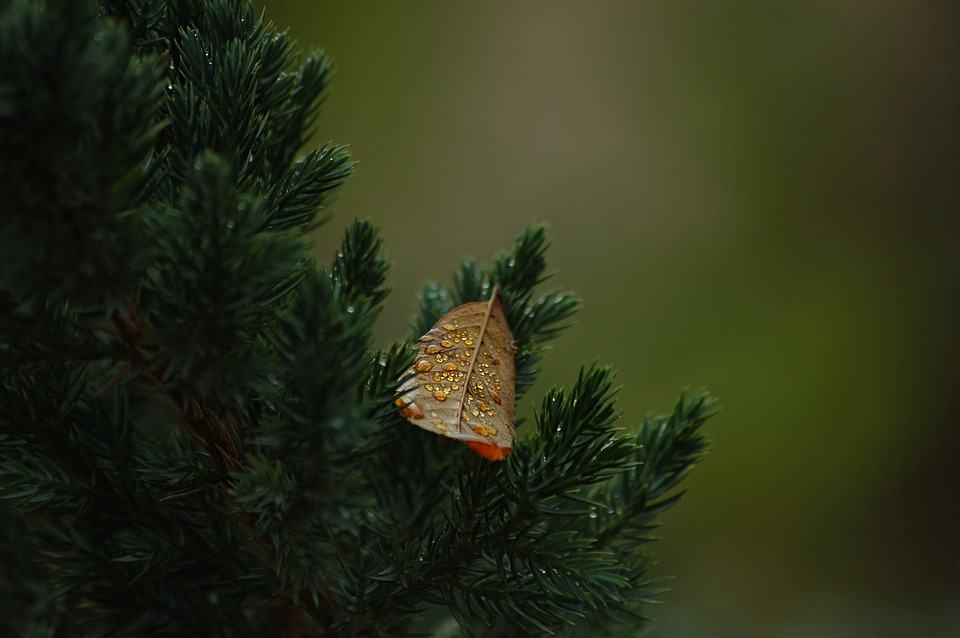
Dwarf spruce bushes provide your front yard with a lot of curb appeal. Moreover, dwarf spruce bushes are easy to care for!
Spruce conifer shrubs are evergreen, low-growing bushes that thrive in bright sunlight. They’re ideal for foundation planting because of their bluish-green hue, needle-like leaves, and widespread growth. Zones 3–8 are suitable for spruce trees and shrubs.
Some of the nicest Dwarf Spruce bushes for planting in front of your house are:
- Picea pungens ‘Glauca Globosa’ – This little spruce is shown as a globe-shaped, blue-grey-needled, rigid bush in photos. The slowly growing dwarf evergreen will mature to a height of 3 to 4 feet (1 – 1.2 meters).
- Dwarf Black Spruce Shrub (Picea marina ‘Nana’) – The dwarf black spruce shrub (Picea marina ‘Nana’) is a charming spherical foundation plant that grows barely 2 feet (60 cm) tall. It likes fertile soil, although it will still survive in poor soil.
- Dwarf Norway Spruce (Picea abies ‘Tompa’) – The ‘Tompa’ spruce cultivar has a conical form and grows to a maximum height of 3 feet (1 m). In a sunny front yard, use as a foundation or entry plant. This plant thrives in Hardiness Zones 4-7.
- Picea abies ‘Nidiformis’ (Bird’s Nest Norway Spruce) – This foundation plant has an oval form with a flattened top. Its flat top has a minor depression in the center, giving it the look of a bird’s nest. The foliage of the ‘Bird’s Nest’ spruce is thick and light yellowish green. The low-growing conifer reaches a height of 3 to 4 feet (1–1.2 meters). It is hardy to zone 2.
- Picea abies ‘Little Gem.’ – Little Gem is a well-loved and sought-after dwarf conifer. It’s an excellent focus for a rock garden, being a small evergreen spruce shrub with thick needle-like leaves and a form of a flattened globe.
- The Dwarf Alberta Spruce (Picea glauca ‘Conica’) – This is a pyramid-shaped foundation conifer. Its attractive appearance and light green leaves make it perfect for landscaping in corners, as entryway plantings, or as an aesthetic complement to other foundation bushes.
Salvia

Salvia is the most extensive genus of plants in the Lamiaceae family (mint family), with approximately a thousand shrub species, herbaceous perennials, and annuals.
From summer through fall, it erupts with pink, white, or purple flowers and green foliage. ‘Ostfriesland’ is tiny purple salvia that grows 18 inches tall and broad in USDA Hardiness Zones 4–8.
Bayberry (Morella pensylvanica (Mirbel) Kartesz)
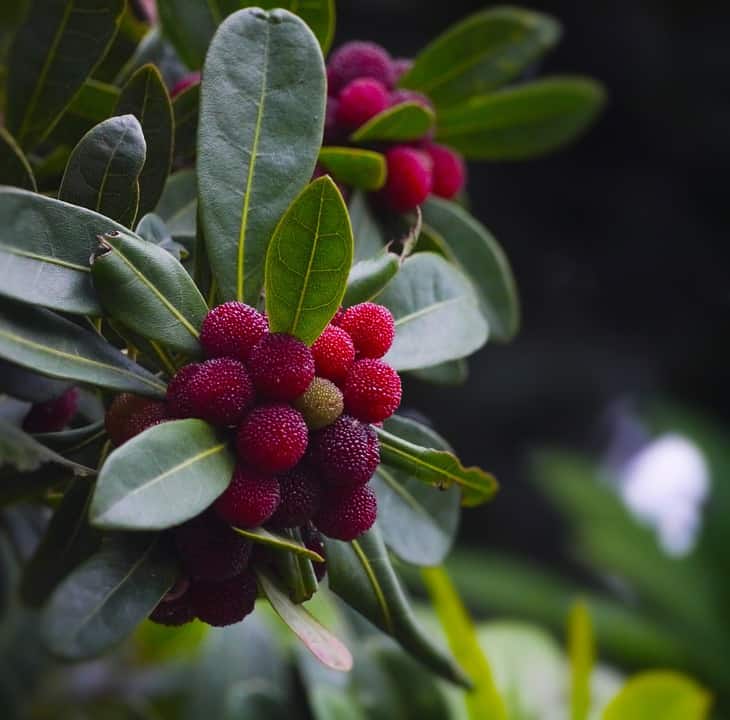
Bayberry, or Morella pensylvanica (Mirbel) Kartesz, is a high-density deciduous shrub with a rounded form that reaches six to ten feet tall.
You can easily cultivate Bayberry in bright sunlight to partial shade on ordinary, dry to medium, well-drained soils. This bush prefers moist, sandy, or peaty, acidic soils but will grow in various soils and environments, such as unhealthy soils, wet soils, strong winds, drought, and salty conditions. Northern Bayberry can even resist fire.
REFERENCES
https://hgic.clemson.edu/factsheet/foundation-plantings/
https://www.rhododendron.org/classification.htm
https://blog.lib.uiowa.edu/eng/change-the-color-of-your-hydrangea-not-magic-its-science/
https://ag.tennessee.edu/utg/Documents/2021_spring_sale/hydrangea_littlelime.pdf
https://cels.uri.edu/testsite/coastalPlants/SpeciesPages/H_macrophylla.htm
https://utianews.tennessee.edu/the-beautiful-but-not-so-familiar-mountain-hydrangea/
https://extension.unh.edu/blog/how-do-i-protect-my-endless-summer-hydrangea-over-winter
https://extension.psu.edu/annabelle-a-favorite-in-the-landscape
www.plantsoftheworldonline.org/taxon/urn:lsid:ipni.org:names:560890-1
https://www.mois.go.kr/eng/sub/a03/nationalSymbol_3/screen.do
https://www.missouribotanicalgarden.org/PlantFinder/PlantFinderDetails.aspx?kempercode=r550
https://inspection.canada.ca/english/plaveg/pbrpov/cropreport/dai/app00007767e.shtml
https://csuvth.colostate.edu/poisonous_plants/Plants/Details/113
https://journals.ekb.eg/article_5400.html
https://doi.org/10.5962/bhl.title.46946
https://www.bellarmine.edu/faculty/drobinson/Boxwood.htm
https://ag.umass.edu/landscape/fact-sheets/boxwood-common-health-issues-in-landscape
https://www.canr.msu.edu/news/browning-of-boxwood-is-it-boxwood-blight
https://plants.ces.ncsu.edu/plants/buxus-sempervirens-suffruticosa/
https://journals.ashs.org/hortsci/view/journals/hortsci/52/3/article-p357.xml
www.public.asu.edu/~camartin/plants/Plant%20html%20files/buxusmicrophyllajaponica.html
https://www.gloucesterva.info/DocumentCenter/View/4243/Boxwoods-PDF
https://www.ars.usda.gov/research/publications/publication/?seqNo115=371295
https://books.google.com.ph/books?id=JpxaLgEACAAJ&dq=isbn:9781845337315&hl=en&sa=X&redir_esc=y
https://www.rwmwd.org/?Type=B_BASIC&SEC=%7B2874F7F4-216C-49AE-A8A0-73062E72001B%7D
https://plants.ces.ncsu.edu/plants/euonymus-fortunei/
https://gobotany.nativeplanttrust.org/family/caprifoliaceae/
https://doi.org/10.1016/B978-0-12-420169-9.00007-2
https://landscapeplants.oregonstate.edu/plants/rhododendron-bow-bells
https://plants.ces.ncsu.edu/plants/rhododendron-eriocarpum/
https://www.rhs.org.uk/Plants/89299/Rhododendron-Blue-Tit-Group/Details
https://www.rhs.org.uk/Plants/60223/Rhododendron-Dora-Amateis/Details
https://ipm.missouri.edu/MEG/2020/6/yews-DT/
https://nph.onlinelibrary.wiley.com/doi/10.1111/j.1469-8137.1973.tb02092.x
https://conifersociety.org/conifers/taxus-baccata-repandens/
https://plants.sc.egov.usda.gov/home/plantProfile?symbol=TACU
https://www.bellarmine.edu/faculty/drobinson/englishyew.asp
https://www.uaex.edu/yard-garden/resource-library/plant-week/inkberry-holly-2-29-08.aspx
https://plants.ces.ncsu.edu/plants/photinia-x-fraseri/
https://www.ncbi.nlm.nih.gov/pmc/articles/PMC1062158/
https://www.conifers.org/cu/Thuja.php
https://plants.ces.ncsu.edu/plants/thuja-occidentalis-hetzs-midget/
https://advances.sciencemag.org/content/6/20/eaba0721
https://advances.sciencemag.org/content/6/20/eaba0721
https://doi.org/10.1016/B978-0-08-088504-9.00269-5
https://www.rhs.org.uk/Plants/55055/nepeta-racemosa-walker-s-low-/Details
https://www.missouribotanicalgarden.org/PlantFinder/PlantFinderDetails.aspx?kempercode=i550
https://www.extension.iastate.edu/news/2005/apr/apr05112.htm
https://www.rhs.org.uk/Plants/91537/Picea-pungens-(Glauca-Group)-Globosa/Details
https://plants.ces.ncsu.edu/plants/picea-mariana-nana/
https://www.chicagobotanic.org/plantcollections/plantfinder/picea_abies_tompa–tompa_norway_spruce
https://landscapeplants.oregonstate.edu/plants/picea-abies-nidiformis
https://bsapubs.onlinelibrary.wiley.com/doi/full/10.3732/ajb.91.7.1115
https://www.fs.fed.us/database/feis/plants/shrub/morpen/all.html
https://www.nrcs.usda.gov/Internet/FSE_PLANTMATERIALS/publications/njpmcpg13479.pdf
https://ia802902.us.archive.org/34/items/CAT83781017/CAT83781017.pdf

